Ideology over interest? Trump’s costly INF decision.
By Steven E. Miller | October 26, 2018
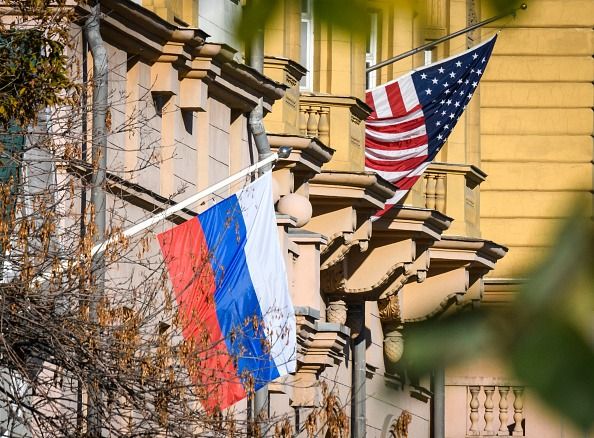 A Russian flag flies next to the US embassy building in Moscow on October 22, 2018. Photo credit: MLADEN ANTONOV/AFP/Getty Images
A Russian flag flies next to the US embassy building in Moscow on October 22, 2018. Photo credit: MLADEN ANTONOV/AFP/Getty Images
One of the puzzling aspects of President Trump’s decision to withdraw from the INF agreement is that there is no reason to take this step now. On the contrary, at present US withdrawal offers few benefits and solves no significant security problem, while raising some potential costs and obvious disadvantages. Russia has been on notice since 2013 that Washington regards Moscow’s ground-launched cruise missile program to be an unacceptable violation of the INF agreement, and the Kremlin can have no doubt that its offending program is subjected to sustained scrutiny by the United States and NATO. If Russia were to deploy a substantial force of non-compliant cruise missiles, this would certainly (and appropriately) spell the end of the treaty and produce a countervailing reaction from NATO. So far, however, Russia has mostly confined itself to testing the ground-launched cruise missiles that are believed, in Washington and Brussels, to have a range that exceeds the treaty limit. Only a tiny and strategically insignificant number of launchers are reported to have been deployed, and these add nothing meaningful to Russia’s ability to threaten targets in Europe (or elsewhere).
The compliance issue must be addressed, of course, but there is no urgent strategic calculation that compels the immediate elimination of the treaty. Some argue that the United States could use land-based intermediate-range missiles in Asia to counter growing Chinese capabilities. But for the American military the western Pacific is primarily a maritime theater. Its ability to deploy air and sea launched cruise missiles is unconstrained, and it is not obvious that US allies in the region will be willing to accept nuclear-armed deployments on their soil.
Withdrawal is a reasonable and defensible response to protracted, unresolved noncompliance with the treaty, but the decision to withdraw should be based on a substantive judgment that on balance this is the path the best serves American and allied interests. The present challenge to US and NATO security from Russia’s ground-launched cruise missile program—a challenge that is minimal—should be weighed against the likely and possible costs of American withdrawal. And withdrawal will produce a number of negative consequences.
By withdrawing, the United States will take upon itself the onus for destroying a treaty that enjoys wide support among its allies, while letting a noncompliant Russia escape the blame. The demise of the treaty will remove the only legal basis for objecting to Russia’s development and deployment of intermediate-range missiles and will prevent it from being held accountable for its alleged violations. If, as many believe, Moscow is seriously interested in deploying intermediate-range cruise missiles that violate the treaty, then for Russia the INF agreement is a constraint and a complication. In that case, terminating the agreement is beneficial for Moscow and will free Russia to deploy whatever INF assets it wishes.
Even if Moscow is not now eager to deploy noncompliant missiles, the end of the agreement and the anticipation of eventual US deployments of intermediate-range cruise missiles in Europe may lead to a Russian buildup of INF capabilities—a reaction already promised by Russian President Vladimir Putin. In either case, the result is another problem for and a bigger nuclear threat aimed at the NATO allies. Meanwhile, the United States has no need, plans or desire for intermediate-range nuclear forces in Europe and in the short run has nothing to deploy.
Further, if history is any guide, many NATO members will be reluctant or unwilling to have intermediate-range nuclear missiles deployed on their territory, and American efforts to find deployment sites in Europe for new intermediate-range systems are sure to be controversial and to produce friction within the alliance. It may prove difficult or impossible for the United States to match or offset whatever intermediate-range nuclear forces Russia deploys in a post-treaty environment. This seems like a mess to avoid rather than a scenario to invite. The Trump Administration is thus aiming to ensure the demise of a treaty that is much more constraining on Russia than on NATO, and that seems likely to cause problems in the West while expanding Moscow’s options. In other contexts, a different balance of costs and benefits might exist, but for now it is difficult to see how one arrives at the conclusion that current circumstances favor withdrawal.
Why, then, has Trump taken this step? The most likely explanation is that the INF agreement is the victim of an ideological assault on arms control. National Security Adviser John Bolton does not worship at what he has contemptuously called “the Church of Arms Control.” He has viewed negotiated agreements as infringements on American sovereignty, as shackles on American power, and as advantageous to America’s rivals. He has been on a multi-decade crusade to oppose and to undo as much arms control as possible (and was a major force behind the US withdrawal from the ABM Treaty in 2002). If the only good agreement is a dead agreement, then the INF treaty was a ripe target: Russia’s violations provided the opening that Trump and Bolton needed. Bolton’s unusually harsh view of arms control may be shared by few, even in the Republican party, but he is the man whispering in the ear of the President. And the President clearly shares a general aversion to international treaties and has made a regular habit of withdrawing from them.
Is there any hope for salvaging the INF Treaty? There is, in fact, a transition period within which it is possible to make efforts to alter the trajectory of US policy. Under Article XV of the treaty, withdrawal requires six months’ notification, including a statement explaining the “extraordinary events” that “jeopardize supreme interests.” During Bolton’s recent Moscow visit he stated that official notification of withdrawal would happen “in due course,” which means that there are at least six months before the treaty ceases to have legal effect and the six-month clock is not yet ticking. How might the time available be used to change the Trump decision? There are four (potentially reinforcing) paths that offer some hope, though none seems likely.
First, and most hopefully, perhaps the announcement of intent to withdraw is another Trump negotiating ploy aimed at exerting pressure on the other side, to gain concessions that allow the president to proclaim that he has improved the treaty, thereby gaining another triumphant diplomatic victory. Such dynamics have been evident in the North Korean case and in the renegotiation of the North American Free Trade Agreement. This scenario would save the treaty, presumably by giving Trump enough grounds to claim that he had resolved the compliance crisis. But this outcome will not be attractive if the true goal of the Trump administration is to kill the treaty rather than to repair the treaty regime.
Second (and perhaps relatedly), Russia has consistently denied that it has committed violations while also claiming that it wishes the INF agreement to be preserved. But to date it has not been sufficiently cooperative to allow the resolution of the compliance dispute; considerable transparency will be required to establish that the capabilities of the SSC8 ground-launched cruise missile fall within treaty limits or, alternately, to alter the Russian program to make it treaty-compliant. Perhaps with the agreement under threat, Moscow will have an incentive to allow clarifications that put the matter to rest—thus giving Trump his victory. But this logic falls apart if Russia is actually happy to be liberated from the treaty constraints.
Third, media reports suggest that most NATO allies are overwhelming opposed to Trump’s INF gambit. The NATO allies have at least six months to push back against the Trump administration’s decision, to explain its costs, and to underscore its likely disruptive effect in the alliance. Perhaps this will increase Washington’s understanding of the costs of withdrawal, though in many other instances—the Paris climate change agreement and the Iran nuclear deal, for example—Trump has been indifferent to the preferences of the allies and unswayed by their arguments.
Fourth, there is an argument that says the end of the INF treaty—a narrow agreement more than three decades old—represents an opportunity to move beyond the Cold War arms control paradigm and to begin thinking about how arms control can be adapted to confront today’s security challenges. It is more important, in this logic, to launch a new arms control process based on new thinking than to save the INF agreement. This is a hopeful interpretation—crisis as opportunity—but there is no indication that the two governments see it this way, and it seems more likely that the death of the INF agreement will hasten the end of arms control than that it will galvanize the rejuvenation of the arms control process.
Witnessing a mortal threat to Ronald Reagan’s signature arms control achievement, Reagan’s former Secretary of State George Shultz has urged what seems obviously to be the wisest course, saying of the INF agreement, “We should fix it, not kill it.” Unfortunately, the record of the Trump presidency suggests that it is in the hands of treaty killers.
Together, we make the world safer.
The Bulletin elevates expert voices above the noise. But as an independent nonprofit organization, our operations depend on the support of readers like you. Help us continue to deliver quality journalism that holds leaders accountable. Your support of our work at any level is important. In return, we promise our coverage will be understandable, influential, vigilant, solution-oriented, and fair-minded. Together we can make a difference.
Keywords: INF, John Bolton
Topics: Analysis, Nuclear Risk, Nuclear Weapons, The INF Treaty and the Future of Arms Control
Share: [addthis tool="addthis_inline_share_toolbox"]


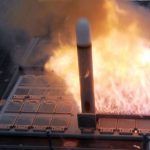
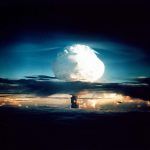
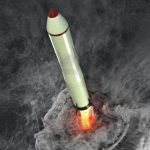

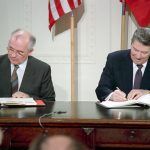








The Theory of Factuality
Controversy (the number of emotional appeals a statement will generate, c) is likely equal to factuality (The number of possible situations the statement is true, t, divided by the number of situations the statement isn’t true, u) times maximum possible Cpu time (Physically 3.11ghz, or for a brain 125mhz), cubed: c=t/uCpu^3,
States pursue what they believe to be in their own national interests. When interests clash with those of another state the result is conflict. During the Cold War the superpowers managed to avoid nuclear holocaust. At times they were very close to the edge, as in the Cuban Missile Crisis, but Kennedy and Khrushchev were able to step back. But can Putin back down – as this expert article teases out – if Trump’s INF move is in fact ‘a ploy aimed at exerting pressure’ on Moscow? It might be dangerous to view things in terms of the Cold War.… Read more »